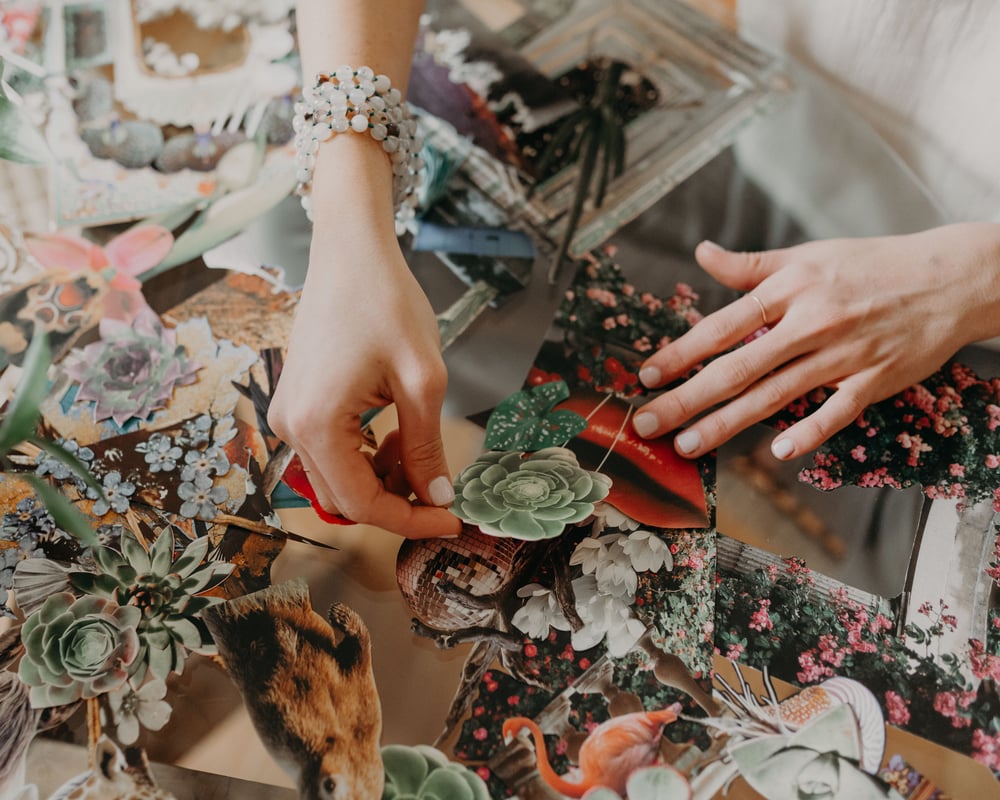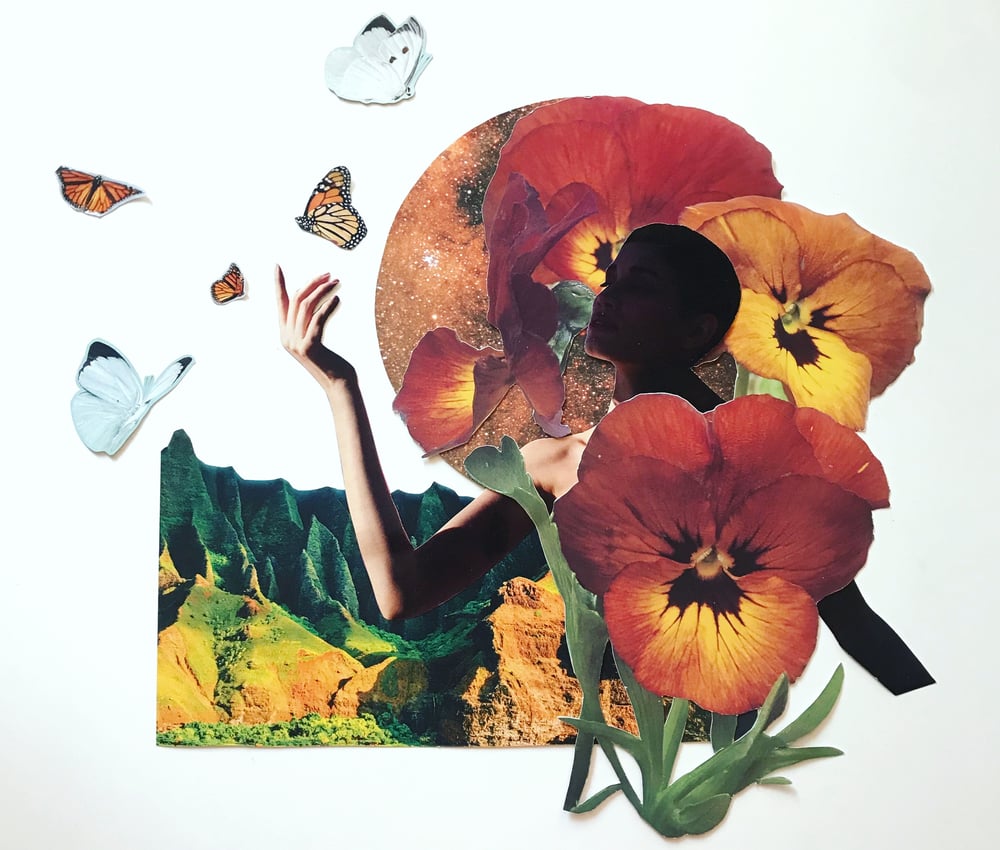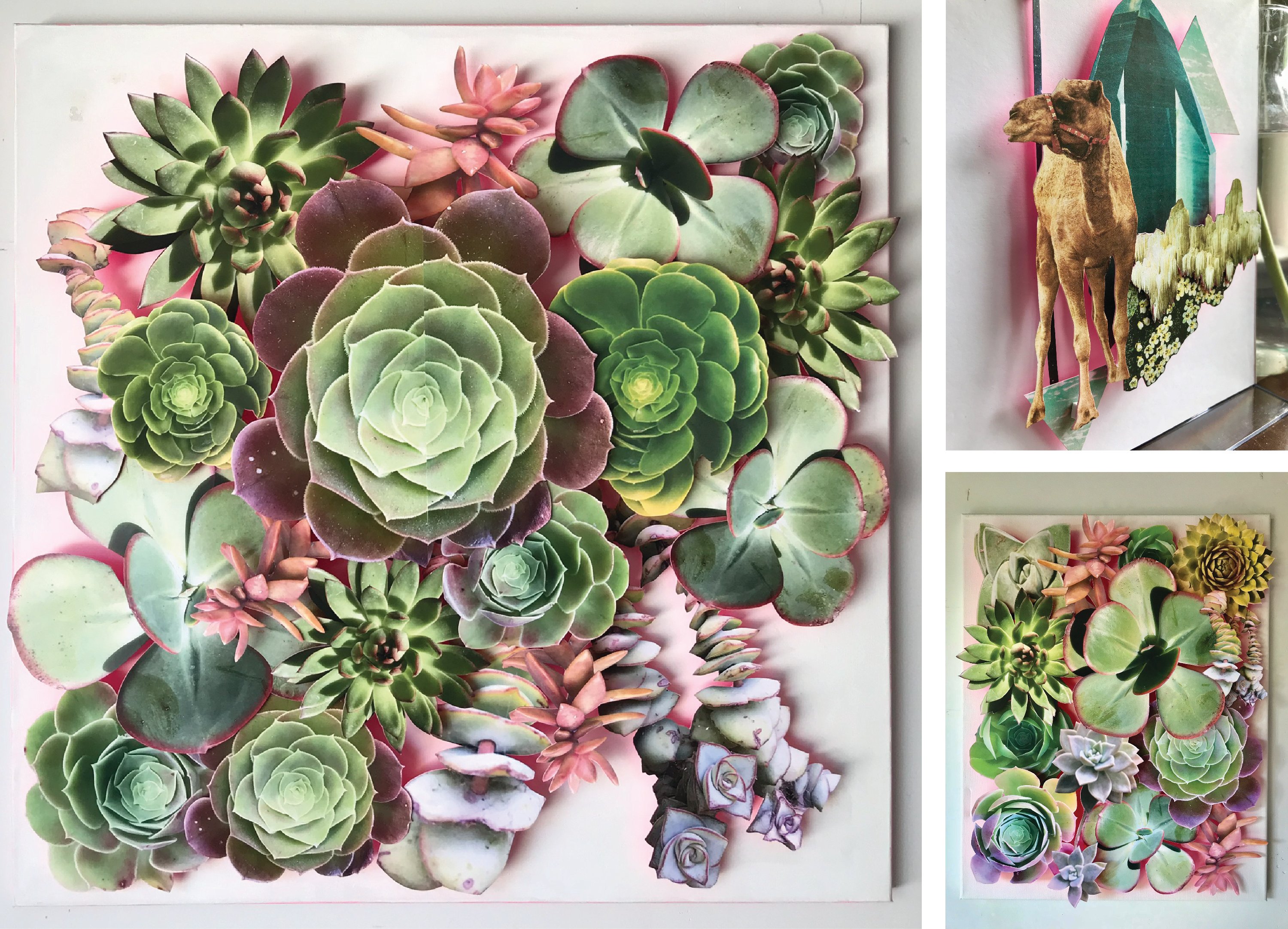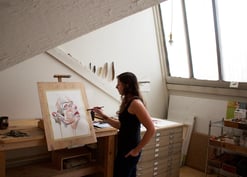As a child, TurningArtist Elisabeth Baker spent most of her time in the backyard. She would get as immersed and entangled as possible in the leaves, branches grasses, and flowers, creating an alternate forest-like environment within her family’s city home. Elisabeth’s obsession with creating these micro-environments became her way of curating an escaped reality from the normal built environment. Her childhood interests have now transformed into artworks that evoke the beauty of the natural world and curated environments. Specifically, Elisabeth’s work attempts to connect individuals to the perfection of nature and evoke the same feeling of awe she experiences as an observer of the natural world. She works in collage, paint, and installation art to create her surreal scenes of nature.
Can you tell us about your process?
Much of my work begins either by finding some beautiful coffee table book or taking photos on my phone. I snap photos of leaves, succulents, and flowers- whenever I come across something inspiring and beautiful. I also seek out vintage books and magazines from second-hand stores for analog collages. For my three-dimensional work, the pieces begin digitally in photoshop. I create the composition using my iPhone photos before printing each piece out, backing it with neon paper, and building the canvas up one plant at a time. For my cut and paste collage, I scour each book and magazine for inspiring imagery and cut out whatever speaks to me. I then store each cut out organized by subject, color, and size. When the time comes to create, I can play with all kinds of different compositions and elements, expanding the possibility for what is possible. I love bouncing back and forth between these two methods and using what I learn in one form to influence the other.  Can you tell us about your journey to becoming a professional artist?
Can you tell us about your journey to becoming a professional artist?
My path to becoming a full-time artist began in high school. I was lucky to have some amazing art teachers that saw my interest in the subject and pushed me to really dive into learning- specifically through oil paint. From there, I knew that art was the only thing I wanted to study in college, so I continued studying painting at CU Boulder. When I was in my last semester of college, a teacher suggested I look into the Anthropologie internship program for display design. I got the job and instantly fell in love with the world of installation art and the beautiful aesthetic of Anthropologie. Throughout my time working for the company, I started an at-home practice of creating collage- as a meditation of sorts and having an at-home creative outlet. Over a span of six years, I worked my way up to the display coordinator position until COVID hit. With so many things changing and becoming uncertain during the pandemic- I decided to take the leap to work for myself as a full-time artist. It has been almost a year since I have made the shift- and I couldn’t be more grateful that my path has formed in this way.
When you are looking for inspiration, what resources do you turn to?
Being in nature is really important for me to get inspired. Not only because my work is so rooted in the natural world and its beauty, but also because it’s where I feel most at home. Whether it’s taking a walk around my neighborhood park and focusing on my breath and the fresh air or spending the day hiking in the mountains- any level of exposure to nature keeps me sane and inspired.
Walk us through a typical day in your studio. What is your routine? Has it changed with COVID-19?
My day always starts with a long morning routine. I take my time drinking hot lemon water, meditating, and resetting before the day. I’m the type of person who likes to have variety throughout the day, so I will work on a combination of studio work, digital art, emails, and social media throughout each day. My mind and creativity feel most fresh in the mornings, so I like to start my day moving my hands and creating - whatever that looks like that day.
 During this challenging time with COVID-19 finding the right rhythm to be productive in the studio can be a challenge, what advice do you have for staying productive and focused?
During this challenging time with COVID-19 finding the right rhythm to be productive in the studio can be a challenge, what advice do you have for staying productive and focused?
For me, prioritizing self-care and maintaining a clean space helps immensely with my productivity. I exercise three to five days a week to keep my mind clear and open for ideas and inspiration to flow in, and I always have an organized studio and home. These things have become even more important to me since COVID. When I’m feeling like I’m not taking care of myself or my space- it’s hard for me to get in the flow of productivity.
What advice do you have for combating creative block?
Getting out of your element and trying new things! Keeping things fresh and challenging myself has always been important to me, but now more than ever- I’m trying to expose myself to new environments, people, sights, and sensations as much as possible. Even if that means taking my dog on a new hike or meeting a new friend for coffee. I think creativity is influenced by so many different things- and getting out of the normal routine allows space for those things to get triggered when they otherwise might not have.
As an artist, how do you measure success? Can you recall a specific event in your career that made you feel successful?
I’ve learned to measure my success by how fulfilled I feel in a given day, and by the excitement, I see people have about my work. I’m really grateful to feel like I am already there (most days at least). There have been a few moments in my art career where I’ve had the thought, “Wow, I remember when this was just a dream, and now I’ve achieved it,” which is an incredibly rewarding experience. However, that feeling is usually fleeting- until the next goal is set and I set the bar higher. This cycle is helpful in growing as an artist and expanding my reach- but for me, success is about enjoying day-to-day life as opposed to the end goal. How do you see the art market changing? Where you do see yourself in this transition?
How do you see the art market changing? Where you do see yourself in this transition?
I think social media is playing a huge role in how we share information, communicate, get inspired, and purchase things- not only in the art realm but in most other industries. I am grateful that I enjoy platforms like Instagram - both to share my artwork with the world and also to meet new people and to find opportunities and friends that I otherwise wouldn’t find.
What advice do you have for artists who are beginning to build their careers? Have there been any habits or strategies that you have adopted that you feel have created more opportunities or visibility for your work?
The best advice I could give to an artist building their career is to try as many different styles and mediums as they feel called to. I remember feeling the need to declare my style and medium from the start, which probably kept me from trying all that was available to me. I think that style comes with time after having tried multiple avenues and mediums- and that it’s also something that frequently changes for a lot of artists. Something that has helped me get my work seen by new eyes and clients has been participating in markets. A good friend of mine started a street food-focused market since COVID started, and setting up a booth there has allowed me to create an entirely new community of friends, clients, and buyers. While the idea of selling my work at a booth didn’t sound appealing at first, it is one of the key things that has helped my career as an emerging artist.
Do you consider yourself, and all artists, to be entrepreneurs? Why or why not?
Absolutely. No matter the degree of “behind the scenes” work that an artist does or doesn’t do for themselves- we have all had to learn to manage finances, taxes, self-promotion, relationship building, and so much more beyond just creating art. Especially at the beginning of an art career, when artists are likely doing all of these things on their own, the proportion of time actually creating art to managing the business of the art is probably quite low.
Failure is an inevitable part of success in any field. Do you have advice for overcoming setbacks?
I always try to think of the “greats” and the most successful people in the world- and remember how many times they failed along the way. From Walt Disney to Misty Copeland, I find inspiration and solace in remembering how many times they tried and failed until they got to where they were, changing the history of their fields as the world now knows them. When I’m holding back out of fear of failure, I try to turn that fear into curiosity- and to remember that I wouldn’t be where I am today without getting curious about what could be.  What sparked your interest in partnering with TurningArt?
What sparked your interest in partnering with TurningArt?
I love that TurningArt connects artists and public spaces that otherwise might never know about one another. As a new artist, I am grateful every time there is an opportunity for people to see my work, and especially if a business likes it enough to want to display it in their space.
What does having your artwork in the workplace and other commercial or public spaces mean to you?
If I can connect people to the perfection and awe of nature, even if just for a moment- I feel that my work has done its job. I think we all inherently know how important human connection to the natural world is, yet life inevitably gets in the way, and we lose sight of that. If viewers are able to fondly remember nature as something beautiful while going about their daily life, then I am happy.
To see more featured TurningArtists, return to our blog. To get Elisabeth's art in your space, set up a free consultation with an Art Advisor here!




.jpg?width=332&height=177&name=%E6%A9%983-2%20(1).jpg)

